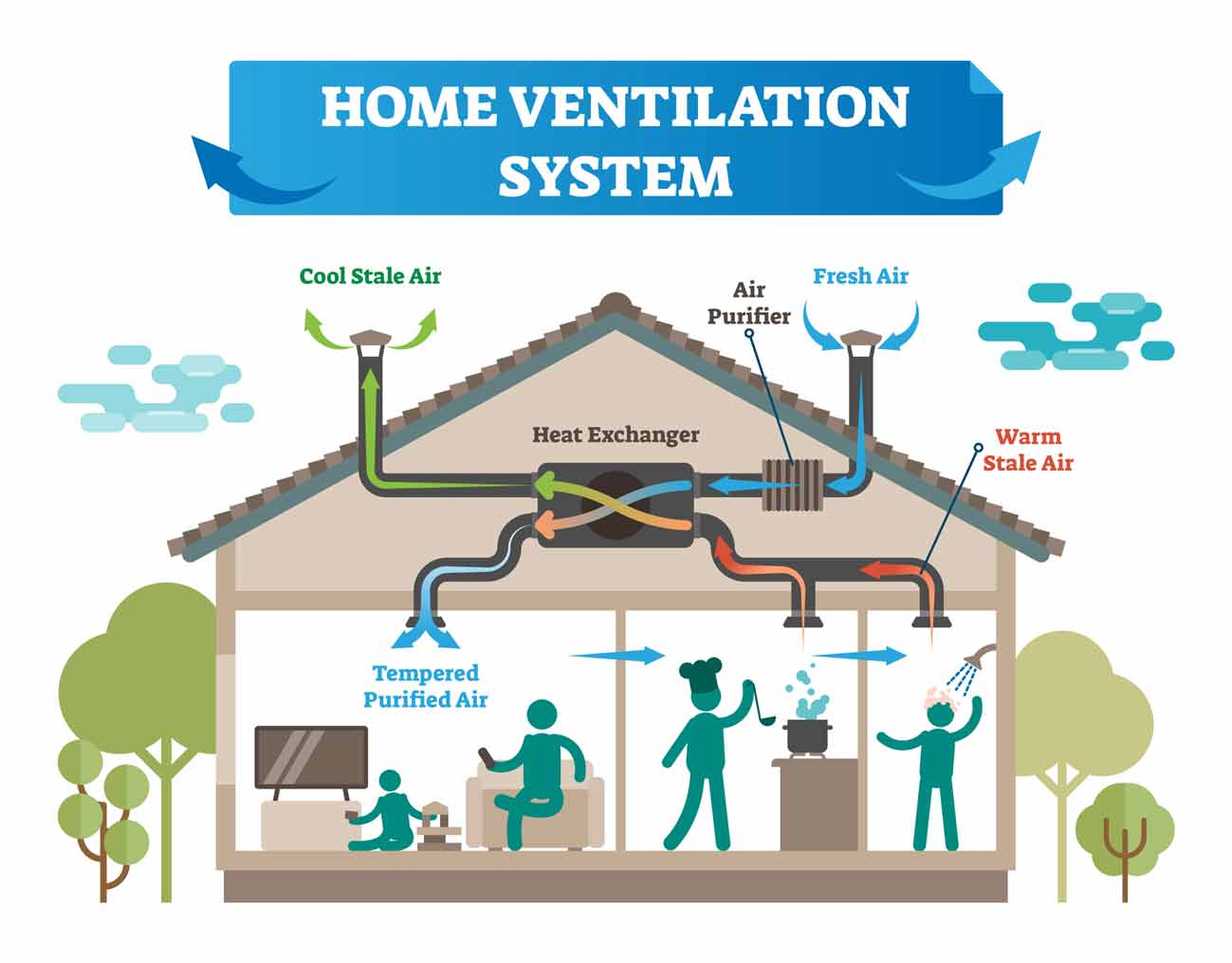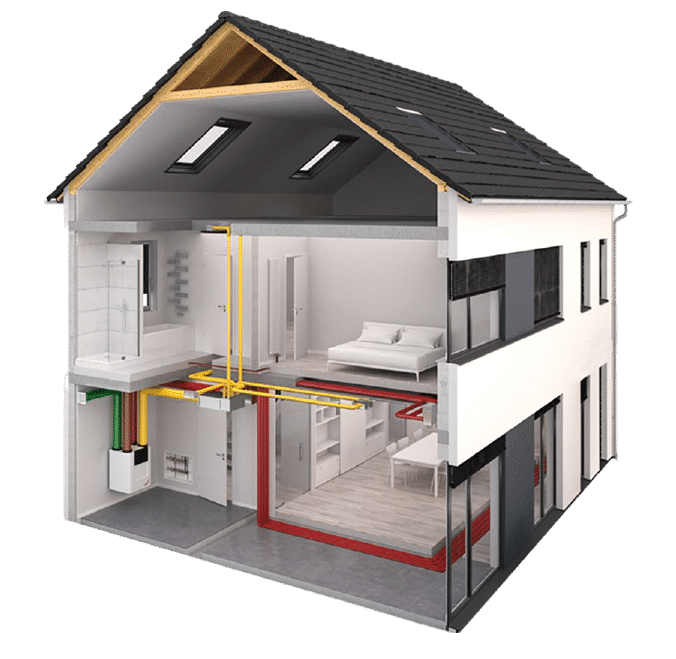HRV Demystified: What Every Homeowner Must Understand
Introducing the Secret Benefits and Uses of Heat Recovery Ventilation in Lasting Layout
Heat Recovery Ventilation (HRV) systems play a crucial duty in lasting layout. They facilitate a continual exchange of stale indoor air with fresh exterior air, substantially boosting interior air top quality. HRVs add to energy efficiency by recovering heat from worn down air, which can reduce utility expenses. Understanding the diverse benefits and applications of HRVs reveals their significance in contemporary style. What other advantages do these systems provide in the pursuit of sustainability?
Recognizing Heat Recovery Ventilation Solutions
Heat recovery ventilation (HRV) systems are developed to enhance interior air high quality while decreasing power loss. These systems use a mechanical air flow technique to exchange stale indoor air with fresh exterior air, making certain a continuous supply of clean air. By catching warmth from the exhaust air, HRVs precondition inbound air, minimizing the demand on home heating and cooling systems. This process not only improves thermal comfort yet likewise adds to energy performance in residential and industrial buildings. Additionally, HRV systems help regulate humidity levels and minimize indoor pollutants, advertising a much healthier living atmosphere. Their calculated application is essential for achieving lasting design goals, as they supply an equilibrium between power preservation and passenger well-being.
How HRV Solution Work
While many might know with ventilation systems, recognizing just how warm recovery ventilation (HRV) systems run is crucial for valuing their advantages. HRV systems operate by trading stagnant indoor air with fresh outdoor air while moving warm in between both streams. This process happens in a heat exchanger, where heat from the outward bound air warms up the inbound air throughout colder months, decreasing energy loss. Alternatively, in warmer months, the system can cool incoming air using the cooler outward bound air. HRVs are equipped with followers to help with air flow and filters to remove particulates, making sure a continuous, well balanced ventilation procedure. This cutting-edge layout not only enhances energy performance but also contributes to keeping a comfy indoor environment.
Enhancing Indoor Air Top Quality
Interior air high quality can greatly affect health and wellness and wellness, making effective ventilation essential in modern homes. Heat Recovery Ventilation (HRV) systems play a crucial duty in keeping indoor air quality by continually trading stagnant indoor air with fresh outdoor air. This process not only reduces airborne contaminants yet also minimizes humidity levels, which can bring about mold and mildew development and respiratory system concerns. HRV systems filter inbound air, getting rid of allergens and particulates, thereby giving a healthier living environment. Additionally, these systems assist eliminate odors and unstable natural substances (VOCs) generally discovered in household products. By making certain a constant circulation of tidy air, HRV systems add to a general improved indoor environment, promoting comfort and wellness for residents.
Power Efficiency and Expense Financial Savings
Energy effectiveness attracts attention as a considerable advantage of Heat Recovery Ventilation (HRV) systems. By catching and reusing the warm from exhausted indoor air, HRVs reduce the energy needed for home heating inbound fresh air, bring about lowered power usage. This effectiveness equates right into lower utility costs, offering substantial cost financial savings for home owners and organizations alike. In addition, HRV systems often get energy performance rewards and discounts, better enhancing their economic allure. In time, the initial investment in HRV technology can bring about a positive return on investment through lowered energy costs. As a result, the combination of HRV systems not only promotes sustainable layout yet likewise gives a practical solution for attaining long-lasting power financial savings and monetary benefits.
Ecological Benefits of HRV

A wide range of ecological advantages emerges from the implementation of Heat Recovery Ventilation (HRV) systems. By effectively moving heat from exhaust air to incoming fresh air, HRVs considerably reduce the power needed for home heating and cooling rooms. This power performance equates to reduce greenhouse gas emissions, adding to a reduction in the general carbon impact of buildings. Furthermore, HRV systems boost indoor air quality by continuously distributing fresh air, thus reducing the concentration of interior contaminants and allergens. The decrease in power consumption help in preserving natural sources, making HRVs a crucial component of sustainable design. In general, the environmental benefits of HRVs play an important duty in advertising a much healthier planet and fostering eco-friendly structure practices.
Versatile Applications in Modern Style
Heat recovery ventilation (HRV) systems are significantly being incorporated right into both domestic and commercial architectural tasks. In property settings, HRVs improve interior air quality while making best use of energy performance. Meanwhile, in industrial rooms, these systems optimize ventilation strategies, demonstrating their convenience in modern-day architectural applications.
Residential Projects Combination
While modern-day style significantly emphasizes sustainability, the assimilation of warmth healing air flow systems in household jobs has actually arised as a functional solution for enhancing indoor air quality and power efficiency. These systems successfully move warmth from exhaust air to incoming fresh air, minimizing power loss and minimizing home heating or cooling down needs. In brand-new builds and retrofits alike, warm recuperation air flow can be effortlessly incorporated, providing home owners with a healthier living atmosphere while decreasing energy prices. In addition, with boosting recognition of ecological effects, even more engineers and building contractors are identifying the lasting benefits of these systems. Consequently, warmth recuperation air flow has become an important part of sustainable property style, showcasing versatility and commitment to environment-friendly methods.
Commercial Areas Optimization
As modern commercial rooms evolve to satisfy the needs of sustainability and effectiveness, the implementation of heat recovery ventilation systems emerges as an essential method for maximizing indoor atmospheres. These systems facilitate the exchange of stagnant interior air with fresh outside air while redeeming heat energy, substantially decreasing power intake. This not just boosts comfort for owners however also helps in decreasing operational prices. Versatile applications can be observed in offices, retail spaces, and schools, where air top quality and temperature control are paramount. Furthermore, incorporating warmth recuperation ventilation lines up with green building certifications, better advertising environmental duty. Eventually, embracing such systems in industrial style not just adds to sustainability objectives however also cultivates much healthier, a lot more productive rooms for individuals.
Integrating HRV Into Sustainable Style Practices
Incorporating warmth recuperation air flow (HRV) systems right into lasting style practices uses considerable benefits in energy efficiency and indoor air quality. By utilizing HRV, developers can create affordable remedies that not just decrease power consumption but also boost the overall convenience of indoor atmospheres. This alignment with sustainability objectives placements HRV as an important element in contemporary architectural strategies.
Power Performance Enhancement
By incorporating warm healing ventilation (HRV) systems into sustainable layout methods, engineers and home builders can significantly enhance energy efficiency in contemporary buildings. HRV systems operate by catching heat from outbound stale air and transferring it to incoming fresh air, minimizing the power needed for home heating or cooling down interior rooms. This process not only reduces dependence on traditional cooling and heating systems yet also reduces general energy usage. On top of that, HRV systems can help preserve a constant interior temperature level, reducing peak power needs. By integrating these systems, structures can achieve considerable decreases in energy expenses and carbon footprints, aligning with sustainability objectives. Eventually, HRV innovation stands for article source a sensible solution for More Help boosting power effectiveness in the built environment, promoting even more responsible resource use.
Indoor Air Top Quality Improvement
Exactly how can warmth recuperation air flow (HRV) systems add to remarkable indoor air quality in contemporary buildings? HRV systems successfully exchange stagnant interior air with fresh outside air while recuperating heat, minimizing temperature variations. This process reduces the concentration of indoor toxins, such as unstable organic substances (VOCs), allergens, and dampness, which can degrade air high quality and influence resident health and wellness. By maintaining optimal humidity levels and making certain a constant supply of tidy air, HRVs help develop a healthier interior environment. In enhancement, these systems can be incorporated into lasting layout methods, advertising energy efficiency along with boosted air top quality. HRV Heat Recovery Ventilation. As a result, HRV innovation plays a crucial role ahead of time total passenger convenience and well-being in contemporary building styles
Cost-efficient Layout Solutions

Often Asked Concerns
What Upkeep Is Needed for Heat Recovery Ventilation Equipments?

Upkeep for heat recovery air flow systems typically includes normal filter substitutes, cleaning of warmth exchangers, evaluation of followers and ducts, and guaranteeing appropriate drainage. These tasks help keep effectiveness and extend the system's lifespan in time.
Can HRV Systems Be Mounted in Existing Structures?
Heat recovery ventilation systems can undoubtedly be set up in existing buildings. HRV Heat Recovery Ventilation. Retrofitting requires cautious planning and evaluation of the structure's design, making certain compatibility with current systems while maximizing energy efficiency and interior air high quality
Just How Do HRV Solution Effect Sound Degrees Inside Your Home?
HRV systems can influence interior sound levels by presenting audio from exterior sources with air flow. Top quality installations commonly incorporate sound-dampening features, decreasing sound impact while offering reliable air exchange and maintaining comfort inside.
Are There Any Downsides to Using HRV Systems?
The disadvantages of using HRV systems include possible high first prices, maintenance obstacles, and the opportunity of decreased indoor air high quality if filters are sporadically changed, which can result in concerns with humidity degrees.
How Do I Select the Right HRV System for My Requirements?
Picking the best heat recovery ventilation system entails examining specific requirements, such as constructing size, environment, and energy performance objectives. Additionally, examining system functions, setup demands, and maintenance factors to consider is important for peak efficiency and complete satisfaction.